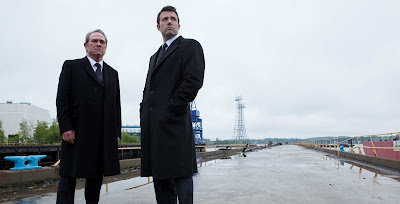Heat Death, 2009
Jeremy Geddes [1] é neozelandês formado em Belas Artes pelo Victorian College of the Arts de Melbourne, Australia, local aonde está agora baseado. Geddes refere que as suas pinturas levam normalmente entre 1 a 5 meses a produzir. Se dúvidas houvesse sobre o trabalho necessário à produção de obras visuais deste calibre, sobre o investimento que é necessário dar de si para chegar a este nível, julgo que fica explícito, aqui abaixo, o que é necessário:
"I work with podcasts or audio books going in the background usually, with the occasional bout of music. I generally work form around 8:30 in the morning until about 11:00 at night, and try to make it 7 days a week." [2]
Cluster, é uma obra ainda em desenvolvimento que podemos seguir no blog do autor [1]
A internet veio abrir um novo meio de subsistência para estes artistas, baseado no modelo económico da "cauda longa". Jeremy Geddes produz as suas obras em tela e a óleo e depois vende online um número limitado (numerado e assinado pelo autor) de giclée prints (poster impresso com spray que garante a fidelidade ao original) por valores a rondar os 200 euros. Se fosse vender apenas numa galeria de arte, nunca conseguiria chegar à imensidão que é um nicho global de pessoas desejosas de ter um quadro seu na parede.
Giclée print de Heat Death
Sobre as ideias visuais
"I’m not sure about the word ‘ideas’, I don’t think that painting is a great medium to express coherent and fully formed ideas, and so I tend not to think along those lines. Instead, I’m more interested in constructing images that are dissonant to some degree, which set up situations that the viewer has to resolve. I think the strength of a painting comes in how much or little information the painter gives to the viewer to aid that resolution." [2]
The White Cosmonaut, 2009
Sobre o processo criativo
"Before I begin a painting, I generally do a lot of thinking. I don't go beyond this point until something has formed in my head which I feel compelled by. Then I play around with it, in my head and in small thumbnails. Then I collect what ever reference I need and get busy. After all the planning though, I usually end up scraping out areas of the painting, and changing them as I go. It's a time waster, but perhaps unavoidable...
I take a lot of photos when I’m out, so I’ve always got many ideas lying around to help spark the beginnings of a painting. Having decent reference as a base (be it photographic or life) is a must, but it will only get you so far; you have to find a way beyond it...
It’s probably more accurate though to say that the genesis for any particular painting lies in music, I usually use a particular piece to help me find the emotional thru-line of a painting, to give me clues in what to add and what to subtract...
The only mental state that can ever allow improvement is to never be satisfied with your work. If you look at a painting of your own and can’t see anything wrong, then you have no avenues for advancement next time around." [2]
A Tribute to the Protestant Work Ethic, 2008-2009
A última obra de Jeremy Geddes é baseada numa obra de literária, do escritor de FC Stanislaw Lem, autor de Solaris.
A Perfect Vacuum, 2011
As obras não são disponibilizadas em HD por razões óbvias de roubo, por isso o que nos é dado a ver é o detalhe de determinadas partes dos quadros, e que podemos ver aqui abaixo da última obra A Perfet Vacuum.
[1] Mais info
Site de Jeremy Geddes
Blog de Jeremy Geddes
[2] Entrevistas
Empty Kingdom Interview: Jeremy Geddes, 2011
Interview with Jeremy Geddes, 2009
Interview with Jeremy Geddes, 2008




















































